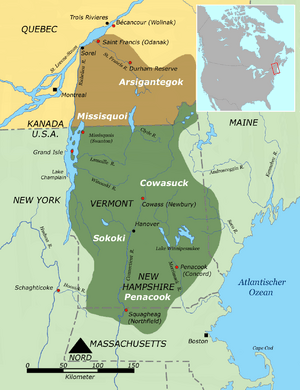Missiquoi facts for kids
| Total population | |
|---|---|
| fewer than 2,101 | |
| Languages | |
| Western Abenaki language, English, Canadian French | |
| Related ethnic groups | |
| other Western Abenaki groups |
The Missiquoi (also called Missisquoi or Sokoki) were a historic Native American group. They lived in the Wabanaki area. This region is now northern Vermont and southern Quebec. This Algonquian group was part of the larger Abenaki people. They lived along the eastern shore of Lake Champlain when Europeans first arrived. Today, they are part of the Conseil des Abénakis d'Odanak. This is an Abenaki First Nation in Quebec.
What Does the Name Missiquoi Mean?
The name Missisquoi comes from the word mazipskoiak. This means "flint people." It comes from mazipskoik, which means "at the flint." This refers to a chert quarry near what is now Swanton, Vermont. Another spelling is Missiassik. It can also be Masipskoik. This word means "where there are many big rocks or boulders" in the Abenaki language.
A Look at Missiquoi History
Before Europeans arrived, some Western Abenaki people built villages. These villages were at the mouth of the Missisquoi River. By the 1600s, Western Abenaki from across Lake Champlain gathered together. They formed a main village at Missisquoi in northern Vermont. Because of this, historians started calling all Champlain Valley Abenakis the "Missisquoi tribe."
The Sokoki people lived along the Connecticut River. They founded Odanak, also known as the village of St. Francis in Quebec. Western Abenakis, including those from the Merrimack River and Champlain Valley, moved north. They went to the Saint-François River in Quebec, Canada. There, they joined the local Odanak community of Abenaki people.
The Missiquoi faced conflicts with French and English colonists. They moved away from these conflict areas during the American Revolutionary War. A historian named Gordon M. Day wrote about this. He said that after the war, the Western Abenakis did not return to their old homes in large numbers. Instead, they joined or rejoined their relatives at Saint Francis.
Some Missiquoi still held onto land claims in the United States. They even collected rent for this land. In 1805, the British Crown gave land near Durham, Quebec, to Abenaki people. These were people who had left during the American Revolutionary War. These lands became the Durham Reserve. By 1850, this group became part of the large St. Francis village (Odanak).
The Missiquoi Abenaki Tribe Today
The St. Francis-Sokoki Band of the Abenaki Nation of Missisquoi is recognized by the state of Vermont. They say they are descendants of the Missiquoi. This group is based in Swanton, Vermont.
The group asked for federal recognition as a Native American tribe in 2007. However, their request was denied. The government's report said that the group claimed to be descended mainly from a Western Abenaki tribe, specifically the Missisquoi Indians. But the report found that there was not enough proof. It said the group could not show they were descended from the St. Francis Indians of Quebec, a Missiquoi Abenaki group in Vermont, or any other Western Abenaki group.
Instead, the report concluded that the group was made up of individuals who claimed to have Native American ancestors. However, they had "little or no social or historical connection with each other before the early 1970's."


